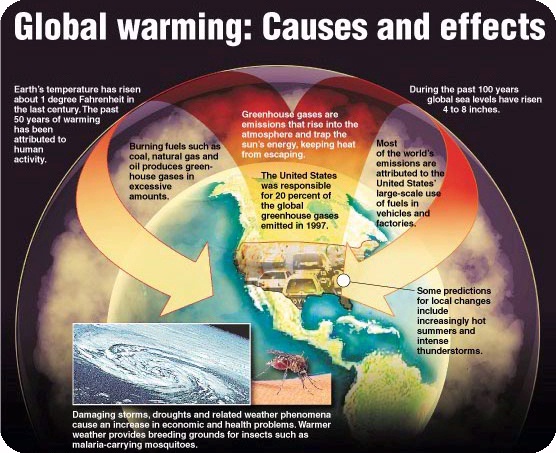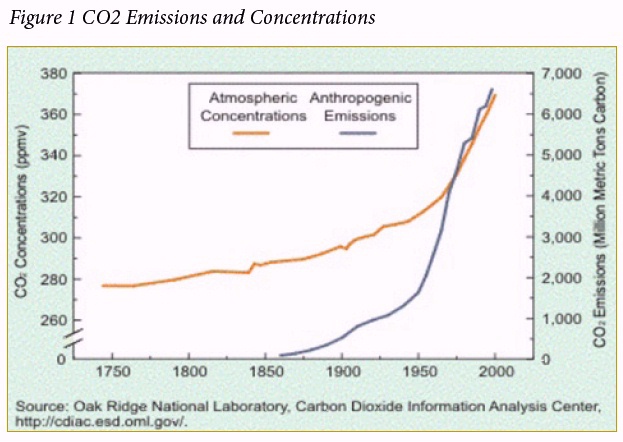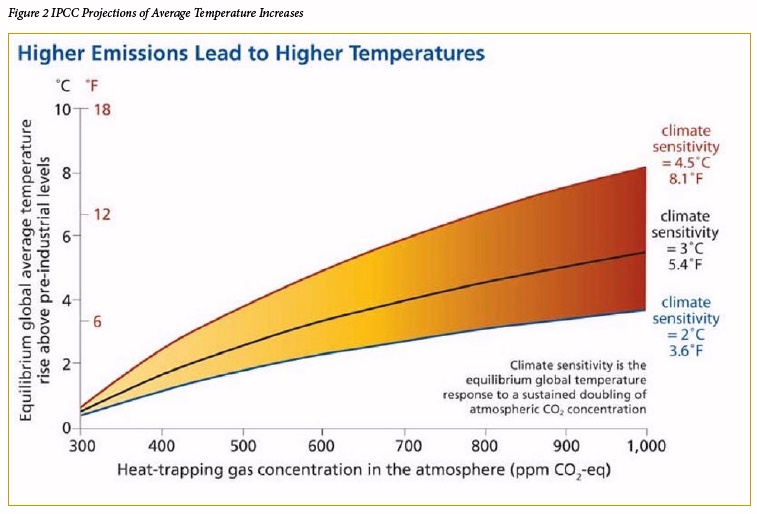|
|
|||||||||||||||||||||||||||||||
|
Climate Change
What is Climate Change? Source: The Icarus Foundation, The Climate Change Challenge - March 2008. Climate Change is caused by the build-up of carbon dioxide and other particulates that prevent some of the sun’s warming rays from being reflected back out of earth’s atmosphere. The burning of carbon-based fuels, notably wood, coal, and oil generates “greenhouse gases” – so-called because their dispersal throughout the upper atmosphere creates a layer that traps the heat from the sun close to earth. Approximately 7 billion metric tons enters the atmosphere each year from human activity. Some of that CO2 is absorbed by vegetation and soils that generate oxygen as a by-product; some is stored in the oceans, but not all. As a consequence, every year the concentration of CO2 and other green house gases increases and the heat from the sun’s rays is trapped within our atmosphere slowly increasing average global temperatures.
 Between 1970 and 2004, global emissions of CO2, CH4, N2O, HFCs, PFCs and SF6 have increased by 70% to 49 Giga tonnes of carbon dioxide equivalents such that the current concentration of greenhouse gases in the atmosphere is equivalent to 430 parts per million by volume – expressed as 430 ppm CO2e. The rate at which greenhouse gases are emitted is accelerating and, without mitigation, can be expected to continue to increase as such populous, rapidly developing nations as China, India, Russia and Brazil embark on their own industrialization and while many developed countries show no sign of extinguishing their appetite for fossil fuels. The average temperature of the earth has increased by 0.8 degrees Centigrade since the beginning of the industrial revolution (i.e. from 1860-2004). According to the National Academy of Sciences, the data suggests that the planet as a whole, is within 1 degree C of the maximum temperature experienced on the planet over the past one million years. In 2005, the concentration of carbon dioxide exceeded the range that has existed over 650,000 years. Eleven of the warmest years since instrumental records have been kept occurred during the last 12 years and therefore climate change is accelerating. In the 20th century, the increase in average temperature was 0.74 degrees centigrade; sea level increased by 17 cm and a large part of the Northern hemisphere snow cover vanished. Some regions are more vulnerable than others – the Arctic region, for example, is warming twice as fast as the rest of the globe. The global warming of the past 100 or so years has already resulted in:
A. More extreme weather patterns (too hot, cold, dry or wet for some); Until relatively recently (the last 3-5 years), there was no scientific consensus that the planet was warming and that this increase in average temperature was caused by human activity. Now the evidence of warming is indisputable although some still argue that its cause may be more due to natural cycles than human activity. While changes in average temperature have occurred on several occasions in the past, they took place over much longer time frames (from thousands to millions of years) giving species time to evolve and adapt. Meta changes are now occurring within decades. The scientific community is unable to predict with absolute certainty the precise level of future increases in average temperature. But the Intergovernmental Panel on Climate Change (IPCC) has suggests that continued emissions will lead to a further warming of between 1.8 and 4.0 Centigrade. The relatively wide range of the forecasts reflects the unknown relationship between various causative factors: continued human use of fossil fuels, the climate’s own sensitivity to changes in CO2 concentration; the synergistic impact of CO2 combined with other gases; the effect of sea level rises, de-forestation and changing levels of freshwater absorbed in the ocean; and the extent to which the global community reduces its emissions. While the ranges are wide, warming at some level is inevitable. Even if greenhouse gas emissions were to cease today, the inertia of the system is such that warming will continue for several decades based on the gases already released and accumulating in the atmosphere and will increase average temperatures by 1.4 degrees C. Climate change may not always be gradual. Systematic average temperature rises can increase the probability of crossing a critical threshold and triggering an abrupt change in climate. Major events such as the collapse of the western Antarctic Ice Sheet; the melting of the Greenland ice sheet; the shut-down of warm water currents such as the Gulf Stream; the destabilization of methane hydrates that exist below the continental shelf; and the declining ability of the biosphere to continue to absorb significant amounts of CO2 could individually, let alone in combination, trigger abrupt and meta changes that could persist for centuries or millennia. For example, many scientists are concerned that the IPCC forecasts have not recognized the speed with which the Greenland ice sheet is melting. Furthermore, current levels of scientific knowledge are insufficient to predict the precise ways in which such increases in average temperature will be expressed in changing climates and weather patterns. The earth is now recognized as a highly complex, adaptive, organic system with every system being connected to and affected by every other. Scientists do not know the precise nature of those inter-dependent relationships – their scale, or direction and speed with which changes can occur. We are entering an Age of Massive Uncertainty and Volatility whereby seemingly small events can have huge and unpredictable consequences for the systems in which they occur. One of the major factors in Global Warming is the emissions that come from the vehicles that we drive around daily. As a result of this many car companies are making serious efforts to lower the environmental impact that their cars have. BMW and Mercedes are two of these companies making changes to their vehicles. There are now special BMW parts that help to control the emissions from their cars. Which makes a big difference when compared to the emissions released from the old classic Cadillac models. You also see many of these companies making more fuel efficient hybrid models while many car owners are taking matters into their own hands by making their cars run off of biodiesel. They can do this to their mercedes by changing out some of the Mercedes parts for their new biodesiel fuel systems. It is efforts like these and the awareness of the people that may help us through these uncertain times. WHAT MIGHT HAPPEN IF THE EARTH CONTINUES TO WARM? The National Academy of Sciences concludes that global warming of a further 1 degree centigrade relative to 2000, will constitute “dangerous” climate change as a result of rising sea levels and extermination of species. The Stern Review (a comprehensive examination of the economic costs of climate change conducted for the UK Government) states that at present rates of greenhouse gas accumulation “there is at least a 77% chance – and perhaps up to a 99% chance, depending on the climate model used – of a global average temperature rise exceeding 2 degrees C. The Intergovernmental Panel on Climate Change (IPCC) that has been researching this phenomenon since the mid 1980s and that has become the primary source of climate change data also considers the 2 degree figure a major threshold with the consequences for human life on this planet, which, if it is exceeded, is considered “dangerous”. While the effects of such an increase would not be experienced in equal measure across the planet, the overall impacts of such an increase would clearly be devastating for the global tourism sector:
It is not as if humanity cannot afford the costs of mitigation and avoidance. The IPCC currently estimates that the cost to stabilize emissions and avoid the 2 degree increase in global average temperature will cost the world less than 3% of the GDP in the year 2030. This means that the prosperity that we would normally achieve by 2030 may be postponed by a few months at the most. It is not a question of affordability but a question of priorities, vision and political will. The cost of stabilizing climate must be seen as an investment, the price of which compares favorably to other investment decisions. Three percent of global GDP in 2007 equals $1.8 trillion – an amount only slightly higher than the $1.6 trillion spent by one country (the United States) on the war with Afghanistan and Iraq and considerably lower than the $22 trillion that the International Energy Authority believes is required to build the infrastructure necessary to cope with rises in global energy demand. HOW LIKELY IS IT THAT SUCH WARMING WILL OCCUR? The plain and short answer is sadly: Very likely. The IEA World Energy Outlook 2007 states that on current energy trends, CO2 emissions will increase 55% between 2004 and 2030. This means that, without strenuous and urgent mitigation actions over the next 20 years, we will be committing the planet to an average increase of between 0.5 and 2.0 degrees centigrade relative to today by 2050 and possibly earlier. Given that the mid-point of that range creates “dangerous” conditions, it is not surprising that climate change has been described as the greatest threat to humanity in our history as a species.
|
|
||||||||||||||||||||||||||||||
|
Website Design + SEO by designSEO.ca ~ Owned + Edited by Suzanne MacNevin | |||||||||||||||||||||||||||||||

